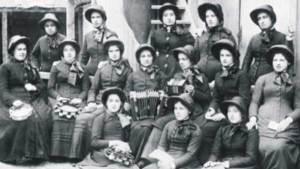This essay first appeared in Cliterati on November 16th; I have modified it slightly to fit the format of this blog.
 Every time one reads an article that doesn’t mindlessly parrot “sex trafficking” hysteria or some other aspect of the anti-sex movement, yet isn’t written by a sex worker or ally, one can be sure there will be an obligatory sentence about how it’s “surprising” or “paradoxical” or whatever that neofeminists are in bed with evangelical Christians. The only people who could actually consider this alliance to be anything other than wholly predictable are those who A) believe in the ridiculous “left wing-right wing” dichotomy which “was a poor fit to real political landscapes when it was first used in reference to the French Assembly more than 200 years ago and has become completely worthless since”; B) accept fanatical cults’ propaganda about their motives as truthful even if it demonstrably conflicts with their public behavior; and C) are completely ignorant of the history of the Anglo-American anti-sex movement. My early essay “Traitors To Their Sex” provides a brief sketch of this history, starting with the influential and charismatic Victorian feminist, Josephine Butler:
Every time one reads an article that doesn’t mindlessly parrot “sex trafficking” hysteria or some other aspect of the anti-sex movement, yet isn’t written by a sex worker or ally, one can be sure there will be an obligatory sentence about how it’s “surprising” or “paradoxical” or whatever that neofeminists are in bed with evangelical Christians. The only people who could actually consider this alliance to be anything other than wholly predictable are those who A) believe in the ridiculous “left wing-right wing” dichotomy which “was a poor fit to real political landscapes when it was first used in reference to the French Assembly more than 200 years ago and has become completely worthless since”; B) accept fanatical cults’ propaganda about their motives as truthful even if it demonstrably conflicts with their public behavior; and C) are completely ignorant of the history of the Anglo-American anti-sex movement. My early essay “Traitors To Their Sex” provides a brief sketch of this history, starting with the influential and charismatic Victorian feminist, Josephine Butler:
…who recognized that English law of the time…stripped prostitutes of their rights as Englishwomen and so campaigned tirelessly for the repeal of those laws for 16 years. At the same time, Butler (like most Victorians) believed that women were essentially asexual, and so could not accept that any woman might freely choose to exploit the male sexual appetite in order to earn a living; the very idea was anathema to her rigid Christian thinking. She therefore concluded that it was actually whores who were the exploited ones, childlike victims of male lust who had been forced into lives of “degradation” by male oppression…after the repeal of the Contagious Disease Acts in 1886 prostitutes were no longer the cause célèbre; when they refused to repent their whoredom and embrace “honest work” and conventional morality the feminists abandoned their sympathy like yesterday’s newspaper and declared war on our entire profession, vowing to abolish it entirely. Butler founded the Social Purity Alliance…dedicated to imposing middle-class Victorian standards of chastity (i.e. repugnance for sex) onto men, and it was but the first of a host of similar organizations which sprang up on both sides of the Atlantic throughout the 1880s and ‘90s…middle-class “feminists” had shown their true colors and abandoned the drive to win rights for the disenfranchised in favor of one which aimed to restrict the rights of everyone…The purity crusaders used many propaganda weapons…but chief among these were disease scares and the “white slavery” hysteria…the unholy alliance of middle-class feminists and puritanical religious zealots managed to convince the public, the media and governments that there was a huge international trade in underage girls, abducted and forced into sexual slavery…The fact that there was absolutely no evidence for such a vast conspiracy made no difference whatsoever; the public devoured lurid stories of child prostitution, and…voluntary adult prostitution was banned or severely restricted under the excuse of combating involuntary prostitution of “children”…
In other words, though some early feminists (such as Mary Wollstonecraft and Olympe de Gouges) were individualists who were not at all anti-sex, feminism did not become a popular movement until it embraced a rigid, puritanical morality. These “first wave” feminists were not merely anti-prostitution, but anti-pleasure; among other things, they campaigned against the “evil” of masturbation and drove the movement which eventually imposed Prohibition on the United States. So although this early feminism died out in the Great Depression, it is wholly unsurprising that its legacy soon infected the “second wave” which flourished in the 1960s and ‘70s; by the mid-‘80s the anti-sex forces had not only taken over feminism, but had sought out and once again joined their old allies, evangelical Christians, in another loathsome attempt to impose a puritanical anti-sex regime on all of society. Almost exactly a century after the first iteration of their social engineering crusade, they’ve brought back most of their old rhetoric (now blended with another morally-bankrupt 19th-century belief system, Marxism) and many of their old tactics, including “white slavery” hysteria (now called “sex trafficking”).
 As I’ve pointed out before, much of the language in “sex trafficking” and other anti-sex articles and essays is positively Victorian, and even when it isn’t the attitudes are. Women like Julie Bindel and Meghan Murphy, who would almost certainly take exception with (or even ridicule) the notion that their attitudes fit more in the late 19th century than the early 21st, nonetheless expend considerable effort in arguing for massive censorship campaigns (even though they deny it) and trying to convince other women that only feminist thought leaders have the right to determine which kinds of sex constitute “rape” or “exploitation”, and that their individual consent is immaterial (the result of “false consciousness”, itself a 19th-century Marxist concept). The “end demand” campaign backed by the Fawcett Society (itself founded in 1866) is based in the tired old Victorian conceit that men can be “taught” to dislike sex as much as prudish women do; furthermore, the recent revelation that the £45 “This is What a Feminist Looks Like” T-shirts hawked by the Society are made in Dickensian sweatshops reveals that middle-class white women’s trivial concerns still trump the serious problems of working-class and brown-skinned women, just as they did in the days when the sun never set on the Empire. And I think we can all agree that the mind which can produce over 3100 words on whether porn can be “ethical” or “feminist” is one which could’ve been perfectly delighted with thinking up new venereal nouns or arguing about how many angels can dance on the head of a pin. So no, it isn’t at all surprising that evangelical feminists conspire with evangelical Christians to make normal people’s lives as miserable as possible; they’ve been doing it for as long as there’s been such a thing as “feminism”.
As I’ve pointed out before, much of the language in “sex trafficking” and other anti-sex articles and essays is positively Victorian, and even when it isn’t the attitudes are. Women like Julie Bindel and Meghan Murphy, who would almost certainly take exception with (or even ridicule) the notion that their attitudes fit more in the late 19th century than the early 21st, nonetheless expend considerable effort in arguing for massive censorship campaigns (even though they deny it) and trying to convince other women that only feminist thought leaders have the right to determine which kinds of sex constitute “rape” or “exploitation”, and that their individual consent is immaterial (the result of “false consciousness”, itself a 19th-century Marxist concept). The “end demand” campaign backed by the Fawcett Society (itself founded in 1866) is based in the tired old Victorian conceit that men can be “taught” to dislike sex as much as prudish women do; furthermore, the recent revelation that the £45 “This is What a Feminist Looks Like” T-shirts hawked by the Society are made in Dickensian sweatshops reveals that middle-class white women’s trivial concerns still trump the serious problems of working-class and brown-skinned women, just as they did in the days when the sun never set on the Empire. And I think we can all agree that the mind which can produce over 3100 words on whether porn can be “ethical” or “feminist” is one which could’ve been perfectly delighted with thinking up new venereal nouns or arguing about how many angels can dance on the head of a pin. So no, it isn’t at all surprising that evangelical feminists conspire with evangelical Christians to make normal people’s lives as miserable as possible; they’ve been doing it for as long as there’s been such a thing as “feminism”.
